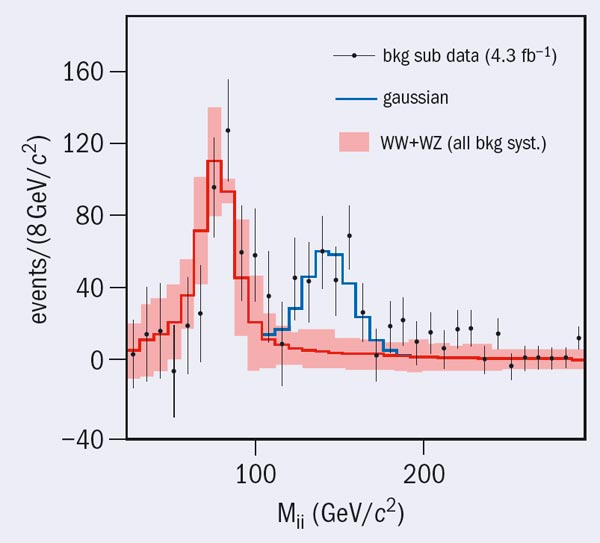
The CDF collaboration at Fermilab’s Tevatron has published two measurements that hint at the existence of physics beyond the well tested Standard Model of particles and their interactions. The first measurement revealed an unexpected asymmetry in the production of top/anti-top (tt) quark pairs. The second analysis unveiled surprising evidence for an excess of events that contain a W boson accompanied by two hadronic jets. The excess cannot be due to the long sought-after Higgs boson but could perhaps be explained by new physics ideas.
While both measurements rely on the Tevatron’s unique ability to produce proton–antiproton collisions, if the new physics hinted at in these results does exist, it will manifest itself in some other form in the particle collisions at the LHC at CERN.
The Tevatron has been producing tt pairs since the early 1990s. In first-order Standard Model calculations, the direction of flight of tt pairs produced in proton–antiproton collisions should be independent of the colliding particles’ charge, thus there should be equal numbers of t and t quarks emitted along either beam direction. More detailed, next-to-leading-order calculations predict an asymmetry of 9 ± 1% at large rapidity, favouring the proton beam’s direction.
CDF announced in March that it measured a tt production asymmetry of 48 ±11% for an invariant mass of the tt pair (Mtt) larger than 450 GeV/c2, which is three standard deviations above the Standard Model expectation. The result is based on the analysis of 5.3 fb–1 of collision data, about half of the number of collisions that CDF has recorded to date. The asymmetries were observed in both the laboratory frame of reference and the tt rest frame. A number of theoretical models predict such asymmetries, including models with a Z’ or large extra dimensions.
The analysis was repeated more recently on events where the t and t quarks decay to a different final state. The asymmetry was again measured at close to a 3 σ level with a value of 0.42 ± 0.15 ± 0.05, averaged over all masses, compared with a 6% Standard Model expectation (T Aaltonen et al. 2011a). This confirms the earlier result with a completely independent data sample.

The second surprising result from CDF started out as a routine Standard Model measurement of collisions, where a W boson was detected in coincidence with two hadronic jets. The team found an unexpected peak in the spectrum of the invariant mass of the pair of jets. The excess of approximately 250 events appeared as a bump around 144 GeV/c2 (T Aaltonen et al. 2011b).
The analysis required the presence of a high-transverse-momentum, isolated lepton; a significant amount of missing energy; and two hadronic jets. The invariant mass spectrum of the jet pair shows a clear peak at 80–90 GeV from a W or Z boson decaying into a jet pair. The surprising peak shows up at a higher mass (figure 2). It has a width compatible with the CDF detector resolution and its significance is 3.2 σ, which takes into account systematics and trial factors. If the peak is from a single particle, the particle would have a production cross-section of approximately 4 pb–1.
The peak cannot result from the Higgs boson predicted by the Standard Model. If a Higgs boson had a mass of 140 GeV/c2 and such a large production rate, both the CDF and DØ experiments at the Tevatron would have seen its decay into pairs of W bosons a long time ago. Furthermore, such a Higgs would decay mainly into bottom-quark jets, which are not observed in an appreciable amount in the CDF data peak. There are, however, new physics ideas that predict the appearance of resonances with the observed features, such as technicolour-based models. If the peak does not originate from a new particle, particle physicists will need to reconsider how the Standard Model is used to make precise predictions for the production of a W boson and two jets.
Physicists from CDF and DØ are in the process of analysing larger data samples, up to 10 fb–1, to either refute or confirm these two results. At the same time, they may find even more interesting signals.
Further reading
T Aaltonen et al. The CDF collaboration 2011a arxiv:1101.0034. Submitted to Phys. Rev. D.
T Aaltonen et al. The CDF collaboration 2011b arxiv:1104.0699. Submitted to Phys. Rev. Letts.





